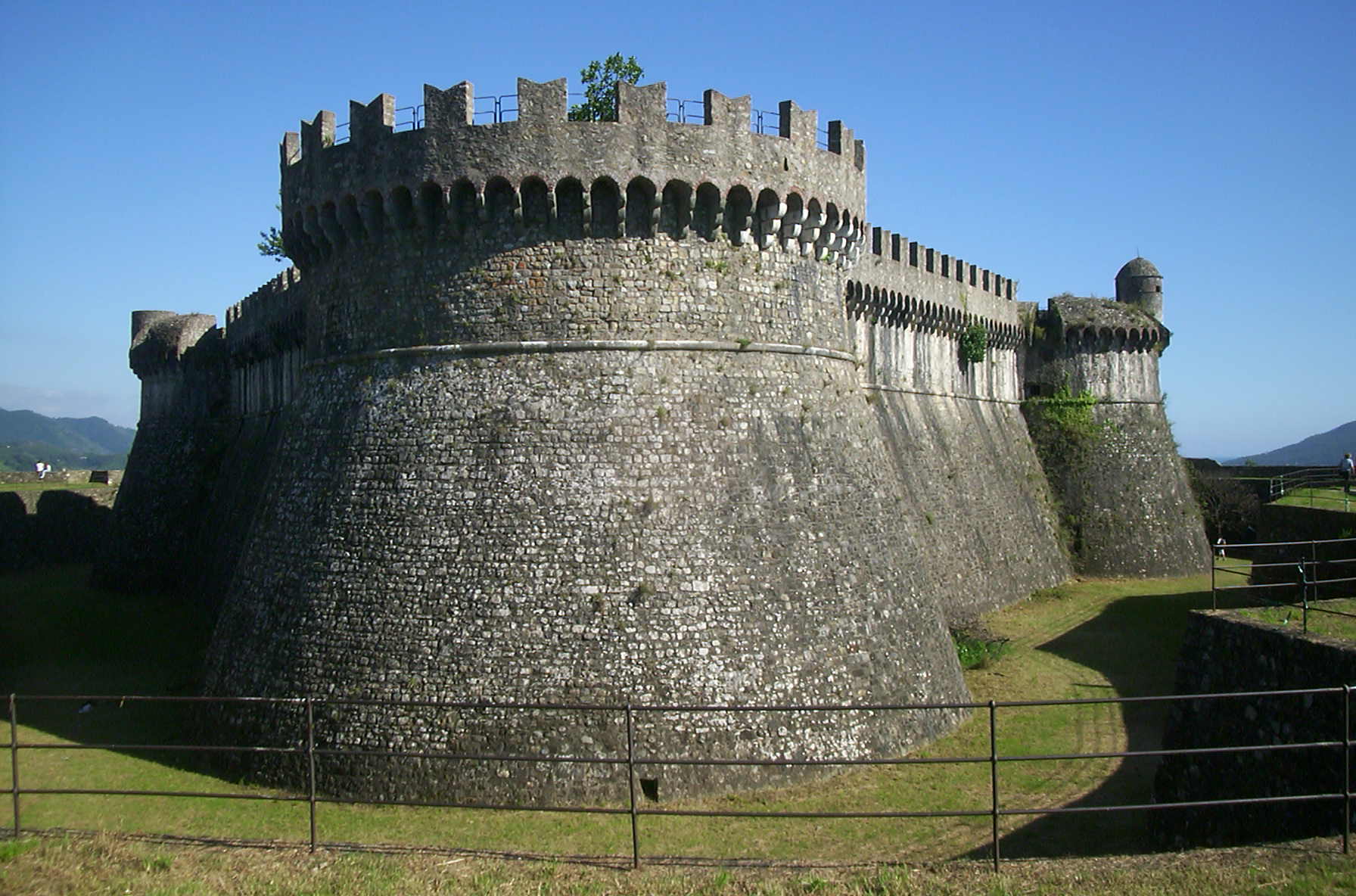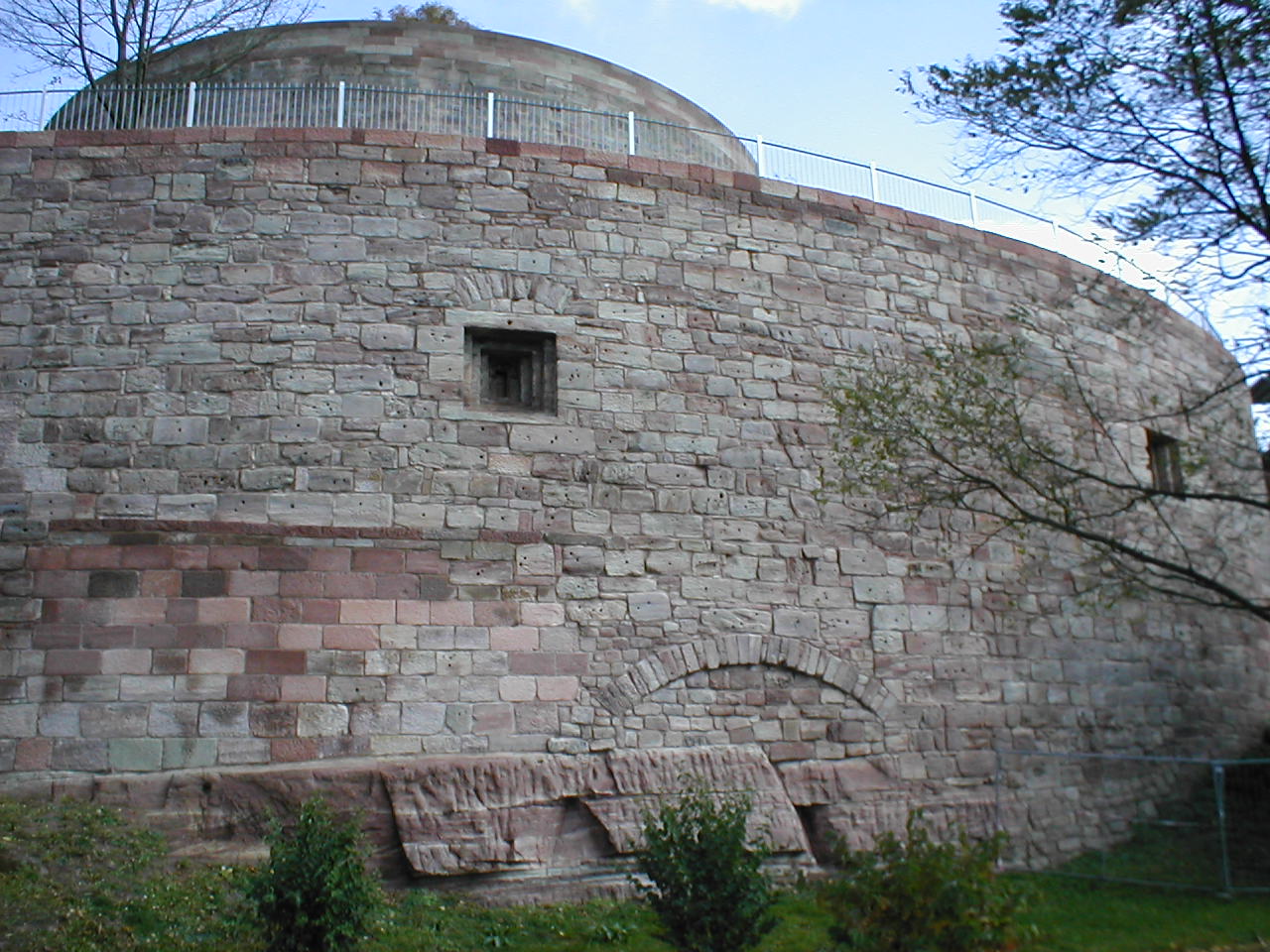Roundel (fortification) on:
[Wikipedia]
[Google]
[Amazon]

 The roundel is an
The roundel is an
 At the fortress of
At the fortress of

 The roundel is an
The roundel is an artillery
Artillery consists of ranged weapons that launch Ammunition, munitions far beyond the range and power of infantry firearms. Early artillery development focused on the ability to breach defensive walls and fortifications during sieges, and l ...
fortification with a rounded or circular plan of a similar height to the adjacent defensive wall
A defensive wall is a fortification usually used to protect a city, town or other settlement from potential aggressors. The walls can range from simple palisades or earthworks to extensive military fortifications such as curtain walls with t ...
s. If the fortification is clearly higher than the walls it is called a battery tower.
Design
The design of a roundel, which was massive in comparison with a normal defensive tower, enabled the deployment of heavycannon
A cannon is a large-caliber gun classified as a type of artillery, which usually launches a projectile using explosive chemical propellant. Gunpowder ("black powder") was the primary propellant before the invention of smokeless powder during th ...
. Roundels were built of both earth and brickwork; in the latter case, vaulted rooms (casemate
A casemate is a fortified gun emplacement or armoured structure from which guns are fired, in a fortification, warship, or armoured fighting vehicle.Webster's New Collegiate Dictionary
When referring to antiquity, the term "casemate wall" ...
s) were built on the inside.
History
Emergence
Roundels appeared in the 15th century whencannon
A cannon is a large-caliber gun classified as a type of artillery, which usually launches a projectile using explosive chemical propellant. Gunpowder ("black powder") was the primary propellant before the invention of smokeless powder during th ...
gradually developed into an effective siege weapon. Roundels are the oldest permanent artillery
Artillery consists of ranged weapons that launch Ammunition, munitions far beyond the range and power of infantry firearms. Early artillery development focused on the ability to breach defensive walls and fortifications during sieges, and l ...
fortifications. Their heyday was in the 15th and early 16th centuries. Early examples of artillery roundels are in the town fortifications of Tábor
Tábor (; ) is a town in the South Bohemian Region of the Czech Republic. It has about 34,000 inhabitants, making it the second most populated town in the region. The town was founded by the Hussites in 1420. The historic town centre is well pres ...
before 1433 and Sion Castle, that around 1426/27, and certainly before the siege of 1437 were modified. Other early central European examples that have survived include roundels at Sigmundskron Castle near Bozen (from 1473), at the Hessian water castle of Friedewald (from 1476), the neighbouring Herzberg (from 1477), Haut-Kœnigsbourg from 1479, Breuberg
Breuberg is a town in the Odenwaldkreis, Odenwaldkreis district of Hesse, Germany. It is 28 km east of Darmstadt and 20 km southwest of Aschaffenburg.
Geography
Location
Breuberg lies in the northern Odenwald.
Neighbouring communi ...
(around 1480), in Halle a. d. Saale (from 1484), in Burghausen a. d. Salzach (around 1488), Heidelberg Palace (around 1490/1500), or the southwest roundel of Marburg Castle (1522–23) and in the shape of the Fulda Roundel in front of Kassel Palace (1523).
Demise
Like the horseshoe-shapedbastion
A bastion is a structure projecting outward from the curtain wall of a fortification, most commonly angular in shape and positioned at the corners of the fort. The fully developed bastion consists of two faces and two flanks, with fire from the ...
, the roundel has a so-called blind spot which makes it vulnerable. In addition, the upper level of a roundel had little space for heavy cannon. Even the casemates of a roundel could only house a few cannon because they created a lot of gunsmoke which only dispersed slowly. The roundel was a stage in the development of late medieval fortifications and did not meet the demands of defensive works of the early modern period
The early modern period is a Periodization, historical period that is defined either as part of or as immediately preceding the modern period, with divisions based primarily on the history of Europe and the broader concept of modernity. There i ...
. Even the construction of large and thick-walled roundels like those at Munot in Schaffhausen
Schaffhausen (; ; ; ; ), historically known in English as Shaffhouse, is a list of towns in Switzerland, town with historic roots, a municipalities of Switzerland, municipality in northern Switzerland, and the capital of the canton of Schaffh ...
built from 1563 to 1585, were an insufficient response to the technology of the time.
As a result of its disadvantages the roundel was replaced in many places during the 16th century by the acute-angled bastion
A bastion is a structure projecting outward from the curtain wall of a fortification, most commonly angular in shape and positioned at the corners of the fort. The fully developed bastion consists of two faces and two flanks, with fire from the ...
with a pentangular ground plan based on Italian practice. In spite of the advantages of the angled bastion, various European fortresses continued to be protected by roundels until well into the 17th century, something that was partly due to the high cost of fortress construction. In addition, expertise on bastion design only spread very slowly across many parts of Europe.
Later design and re-emergence
For decades after the invention of the angled bastion, roundels were built, albeit now more often in combination with earthworks or rock and earth combinations (artillery ramparts) as part of a continuous main defensive line that gave greater protection from artillery fire. Examples of the more recent type are the two roundels (and connecting artillery ramparts on the west side of Heidelberg Castle (from ), the expansion of Celle's town fortifications (around 1530) (not preserved), the six roundels of the small town of Pfalzel an der Mosel (from 1532), the four artillery towers of Solothurn (from 1534), the three mre recent roundels of the Sparrenburg aboveBielefeld
Bielefeld () is a city in the Ostwestfalen-Lippe Region in the north-east of North Rhine-Westphalia, Germany. With a population of 341,755, it is also the most populous city in the administrative region () of Detmold (region), Detmold and the L ...
(from 1535) and the roundel at the Württemberg state fortress of Hohentwiel (from 1538). Even the imperial city of Nuremberg
Nuremberg (, ; ; in the local East Franconian dialect: ''Nämberch'' ) is the Franconia#Towns and cities, largest city in Franconia, the List of cities in Bavaria by population, second-largest city in the States of Germany, German state of Bav ...
built between 1527 and 1550 several smaller roundels and between 1556 and 1559 the four prominent round towers at the main gates as artillery platforms, as did the imperial town of Rothenburg ob der Tauber
Rothenburg ob der Tauber () is a town located in the district of Ansbach (district), Ansbach of Mittelfranken (Middle Franconia), the Franconia region of Bavaria, Germany. It is well known for its well-preserved Middle Ages, medieval old town, a d ...
in 1572. Many fortresses consist entirely of interlinked roundels, for example Deal Castle on the south coast of England, the construction of which had been started in 1539. In the late 18th and 19th centuries, roundels came back into vogue due to changes in military technology
Military technology is the application of technology for use in warfare. It comprises the kinds of technology that are distinctly military in nature and not civilian in application, usually because they lack useful or legal civilian application ...
.
Plassenburg example
 At the fortress of
At the fortress of Plassenburg
Plassenburg is a castle in the city of Kulmbach in Bavaria. It is one of the most impressive castles in Germany and a symbol of the city. It was first mentioned in 1135. The Plassenberg family were Ministerialis, ministerial of the counts of And ...
in Kulmbach there are two "staggered" roundels. One is a high, inner, roundel built within a much larger outer roundel. This construction is one of the largest surviving roundel works in Germany. The inner and outer roundels house two gun decks, which meant that a staggered roundel could generate a heavy weight of fire from four batteries. The fortress with its roundels was used by the army until the Napoleonic Wars
{{Infobox military conflict
, conflict = Napoleonic Wars
, partof = the French Revolutionary and Napoleonic Wars
, image = Napoleonic Wars (revision).jpg
, caption = Left to right, top to bottom:Battl ...
in 1806. The two roundels in the west of the fortress were rebuilt after the place had been slighted in 1554 following the Second Margrave War, although by that time bastions had already superseded them. Subsequently, between 1557 and 1607, more bastions were added.
Literature
* Olaf Wagener, Thomas Kühtreiber: ''Taktik und Raum. Vorwerke als Elemente des Burgenbaus im 15. und 15. Jahrhundert'', in: Die Burg zur Zeit der Renaissance. Berlin, Munich, 2010, pp. 111–126, . * Stephan Hoppe: ''Artilleriewall und Bastion. Deutscher Festungsbau der Renaissancezeit im Spannungsfeld zwischen apparativer und medialer Funktion'', in: Jülicher Geschichtsblätter, 74/75 (2006/2007), pp. 35–63. * Burger, Daniel: Die Landesfestungen der Hohenzollern in Franken und Brandenburg, in: Die Plassenburg, Schriftenreihe für Heimatforschung und Kulturpflege in Ostfranken, Kulmbach, 2000. * Horst W. Böhme, Reinhard Friedrich, Barbara Schock-Werner (ed.): ''Wörterbuch der Burgen, Schlösser und Festungen.'' Reclam, Stuttgart, 2004, * Hartwig Neumann: ''Festungsbau - Kunst und -Technik.'' Bechtermünz, Augsburg, 2000, . {{Fortifications Castle architecture